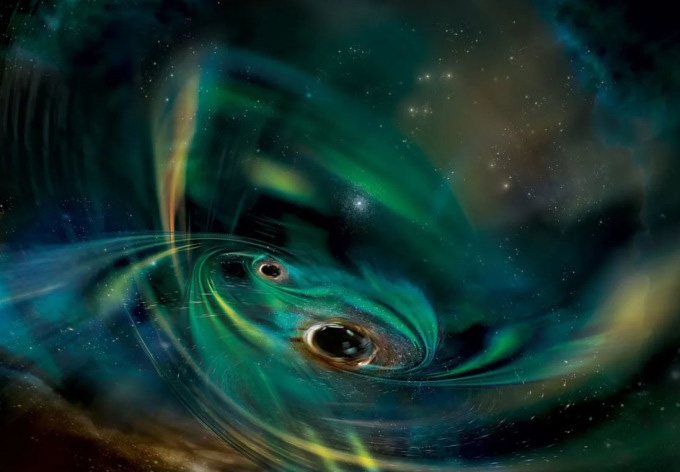Supermassive black hole pair shares 'meal' for the first time
Astronomers have discovered two supermassive black holes in the galaxy 2MASX J21240027+340911 orbiting each other closer and closer, both sucking in interstellar matter.
The galaxy 2MASX J21240027+340911 is known to have an active nucleus for about a decade. At its core, a supermassive black hole is gobbling up interstellar matter, gas, or dust, as it gets too close. Recently, astronomers detected a repeating signal from the object, suggesting a more complex structure: Not one, but two supermassive black holes are at the galaxy's core—and they're sharing a meal.

Simulation of a pair of monster black holes swirling in a gas cloud NASA/Aurore Simonnet. (Image: Sonoma State University).
The pair of black holes have a combined mass of 40 million times that of the Sun and are about one light day apart, or about 26 billion kilometers. The pair are expected to collide in about 70,000 years, and they orbit each other closer and closer every 130 days. It is this orbital motion that creates the observed repetition.
In a study published in the journal Astronomy & Astrophysics, lead author Lorena Hernández-García, an astrophysicist at the Millennium Institute for Astrophysics and Valparaíso University in Chile, said it was a very strange event . "We think that a gas cloud has enveloped the black holes. As they orbit each other, these black holes interact with the cloud, disturbing and consuming its gas. This creates an oscillating pattern in the light emitted by the system."
The team considered several possibilities. It could be common behavior in an active core. Or, it could be a star that got too close to the supermassive black hole, was torn apart, and then slowly consumed. But a pair of supermassive black holes, shrouded in a cloud of gas, 'dining' while orbiting each other, is the most convincing hypothesis.
The team plans to continue monitoring the event to better model what's happening, as well as study the host galaxy undergoing the merger, which is 1 billion light-years from Earth.
- The supermassive black hole closest to Earth glows intensely
- Researchers are about to film a supermassive black hole
- The supermassive black hole was discovered 34 billion times larger than the Sun.
- Super-large black hole rotates rapidly near the speed of light
- Discover the mysterious 'food source', feeding on supermassive black holes for millions of years
- Video: Compare the size of black holes in the universe
- Detecting the supermassive black hole is spraying material
- The first time I took a picture of a black hole three million times bigger than Earth
- The three galaxies unite to
- The black hole can only expand to 50 billion times the mass of the Sun, it is impossible to 'eat to grow'
- The supermassive black hole rotates at the speed of light
- The universe will have the largest ever explosion of two black holes
 Van Allen's belt and evidence that the Apollo 11 mission to the Moon was myth
Van Allen's belt and evidence that the Apollo 11 mission to the Moon was myth The levels of civilization in the universe (Kardashev scale)
The levels of civilization in the universe (Kardashev scale) Today Mars, the sun and the Earth are aligned
Today Mars, the sun and the Earth are aligned The Amazon owner announced a secret plan to build a space base for thousands of people
The Amazon owner announced a secret plan to build a space base for thousands of people